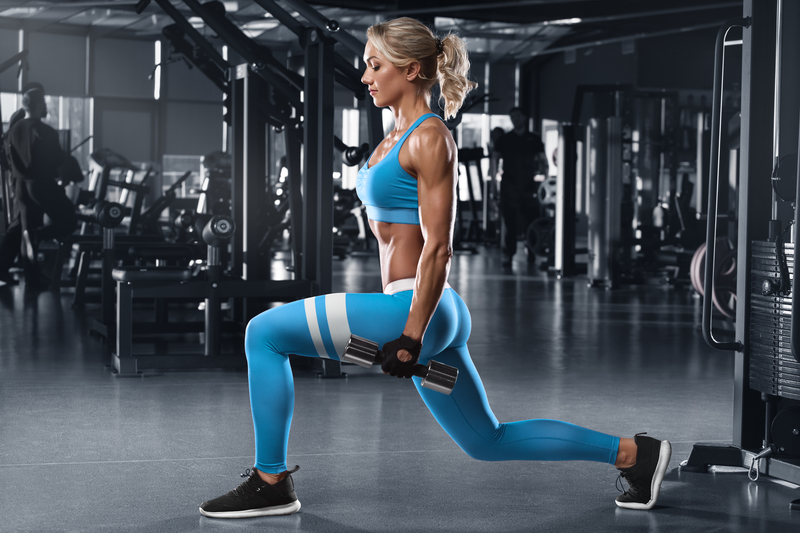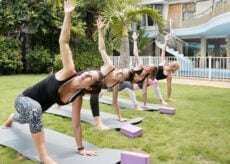How to Do a Lunge Properly (For All Fitness Levels)

Lunges are a staple in any good workout program, but knowing how to do a lunge properly may be a less common occurrence. Yet, if you want to maximize the effectiveness of your workouts and reap the myriad benefits proper lunges can bring you, it’s worth taking the time to learn how to perform them properly and to reassess your form regularly to ensure you aren’t picking up any negative habits.
Get the lowdown on how to do a lunge properly with these simple tips.
What Are Lunges?
A lunge is quite similar to a squat in theory, but the main focus is to work on one leg at a time with your legs split—one leg in front, back, or to the side with the knee bent. A lunge taxes most of the muscles in the lower body, including the glutes, hamstrings, quadriceps, and calves. Your core is also engaged as you perform the movements, and if you decide to use additional weight with your lunging regimen, you could possibly include the use of your upper body as well.
What Are the Benefits of Lunges?
If you like the look of a sculpted lower body, you’ll love the added benefits that doing lunges on the regular will bring.
- They are a functional movement. Lunges mimic the way you walk, run, go up and down stairs, and more. Strengthening your legs in this manner can help you across the board in your daily activities.
- Work multiple muscles simultaneously. If you like to multitask, then this is the exercise for you! Not only do lunges work the obvious (the fronts of your legs, or quadriceps), they also challenge your hips, glutes, hamstrings, and core.
- Build strength. Let’s face it, being stronger doesn’t hurt. Having a strong base can provide benefits when it comes to power, balance, calorie-burning, stamina, and is one of the keys to longevity.
- Increase your stability. The more you practice your lunges, the better your stability will become. Because you are basically balancing on one leg as you perform the movement, it may be advisable to work slowly at first until you feel confident in your form and stability. Over time, you’ll get stronger and balancing will become a breeze, even with added weight.
How to Do a Lunge
There are many forms of lunges you can do, but learning how to do a forward lunge is essential. Begin by standing with your feet hip-width apart. To do a basic lunge, you can keep your hands on your hips throughout the movement. Take a giant step forward with your right leg and bend at the knees.
Keep your torso upright and look forward as you progress through the movements. Your front knee should not pass a 90-degree angle nor go past your ankle, especially if you are prone to knee pain. You aren’t going forward; you’re going down with your knee over your ankle.
Allow your back leg to track naturally as you move forward. You’ll be on your toes on the back leg as your body moves forward. Your back leg will be bent at 90-degrees when you are at the peak of the lunge movement and your knee should be close to the ground.
Hold this position for a few moments and then push up through your front (right) heel to move your body upward and forward. Allow your rear leg to come back to the starting position as you stand again and prepare to duplicate the process on the opposite side.
If you shorten the “step” you take when lunging, you’ll place more of a focus on your quadriceps and the fronts of your legs whereas if you take larger, long steps, you’ll engage more hamstrings and glutes.
Try these Lunge Variations
Reverse Lunge—start with the same foot and body placement as your forward lunge. Instead of stepping forward with your right leg, take a giant step backwards with that leg until your knee almost touches the ground. Your shin should almost be parallel to the ground as well while your front leg (left leg) will bend naturally at the knee.
Your upper body should also remain upright throughout the movement. Raise your arms straight up above you and touch your palms together. Hold this lowered position for a few moments before pushing through your left heel to bring yourself back to the standing position. Repeat for your left leg.
Side Lunges—this version of lunges helps you strengthen the stabilizer muscles in your legs. When you break out of your normal circle of comfort (i.e., forward and backward movements), you allow yourself to build up strength, reduce your chances of injury, and you can improve your balance. Start by standing with your legs about hip-width apart. You can clasp your hands in front of you to help yourself balance or place them on your hips.
With your right leg, take a giant step out to your right side and simultaneously bend your left knee until it’s at about a 90-degree angle while keeping your right leg straight. While bending, push your hips backward as if you were going to sit on a chair.
Push off through the heel of your left foot to return to standing and bring your right leg back toward the center of your body. Repeat on the opposite side.
Walking Lunges—these lunges can really help you tone your legs and also burn off a lot of calories as they take quite a bit of energy to perform.
Begin by standing with your feet hip-width apart. Place your hands on your hips and keep your upper body as upright as you can throughout the movement. Take a giant step forward with your right leg and place your foot flat on the ground. Bend your knees until your front thigh is parallel with the ground and your knee is in line above your ankle. Pause and push through your front heel while swinging your left leg through and forward.
Take a giant step forward with your left leg and bend at the knees repeating the motion from the right side. Continue alternating steps for at least ten repetitions on each side.
Coach Note: You can add even more variation to your routine by holding dumbbells or kettlebells in your hands as you lunge. Or, try lunging with a band around your knees for added resistance as you go through the movements.
To work all of the muscles in your lower body and core, choose a variety of lunges in your workouts. Once you learn how to do a lunge properly, you will be rewarded with improved strength, stability, and more shapely thighs, glutes, and calves!






